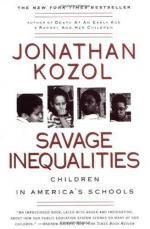
|
| Name: _________________________ | Period: ___________________ |
This test consists of 5 multiple choice questions, 5 short answer questions, and 10 short essay questions.
Multiple Choice Questions
1. What was the former purpose of the building that houses PS261?
(a) Roller skating rink.
(b) Movie theater.
(c) Factory.
(d) YMCA.
2. Which school did President George H.W. Bush attend?
(a) Dearfield Academy.
(b) Dearborne Academy.
(c) Phillips Academy.
(d) St. Johns Academy.
3. Where do most of the motivated children at Morris High School plan to go after they graduate?
(a) The military.
(b) To work.
(c) Technical school.
(d) Community college.
4. According to Kozol, students in what racial group are more often categorized with a speech disorder?
(a) White.
(b) Hispanic.
(c) Asian.
(d) Black.
5. What does Kozol say the high math and reading test scores in America are based on?
(a) How well-prepared the students are.
(b) How much funding the schools receive.
(c) How smart the students are.
(d) How badly other schools are doing.
Short Answer Questions
1. According to Delabian Rice Thurston, where do the rich in Washington, D.C. try to send their children?
2. How many students attend Camden High School?
3. According to Thurston, why are poor people in Washington, D.C. willing to accept a dual system of public education?
4. How many districts are New York schools divided into?
5. What does Kozol say Camden's entire property wealth of $250 million is less than the value of?
Short Essay Questions
1. How does the court ultimately rule in the class-action suit filed in 1981 by parents of school children in East Orange, Camden, Irvington, and Jersey City? What is the reaction of wealthier tax payers?
2. Why does Kozol think that inner city problems would not be totally solved by better schools?
3. Where does Delabian Rice-Thurston say the rich and middle class in Washington, D.C. try to send their children to school? Why don't the poor parents send their children to the same schools?
4. Describe PS 79.
5. How does Kozol describe the two worlds of Washington, D.C.?
6. What similarity exist between selective schools in New York and Chicago?
7. Why do public schools in certain areas of New York suffer more than others?
8. How does Kozol describe the D.C. school system?
9. Describe the Milliken v. Bradley case's appeal to Supreme Court.
10. How do the children attending public schools in the suburbs of New York that Kozol interviews feel about sharing funding and resources with children at urban public schools?
|
This section contains 1,092 words (approx. 4 pages at 300 words per page) |

|




